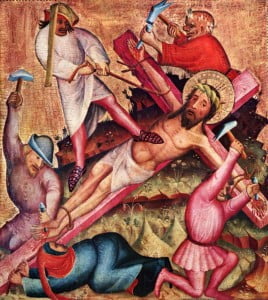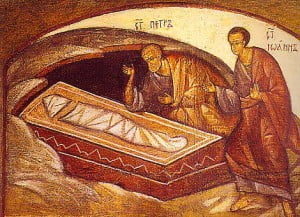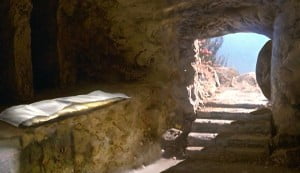Evidence for the Resurrection
 When considering the prove for Jesus' resurrection, we need to separate two issues. First, what are the historical facts that require an explanation? And, second, what is the best, most plausible, explanation for those facts?
When considering the prove for Jesus' resurrection, we need to separate two issues. First, what are the historical facts that require an explanation? And, second, what is the best, most plausible, explanation for those facts?
What are the facts to consider in relation to the resurrection?
Outset, Jesus died on the cross, a victim of Roman execution as a mutual criminal. The Romans were very experienced at this, and knew how to check that someone was dead. If they had non died shortly plenty, and then they broke the legs of the victim who would so suffocate, unable lift themselves up on their legs to accept a breath. In John's gospel, this is recording in some item.
At present it was the day of Preparation, and the side by side day was to be a special Sabbath. Because the Jewish leaders did not desire the bodies left on the crosses during the Sabbath, they asked Pilate to have the legs broken and the bodies taken downward. The soldiers therefore came and broke the legs of the get-go man who had been crucified with Jesus, and then those of the other. Merely when they came to Jesus and found that he was already dead, they did non break his legs. Instead, ane of the soldiers pierced Jesus' side with a spear, bringing a sudden flow of claret and h2o. (John 19.31–34)
What is fascinating about this business relationship is that the writer sees the water and blood as having symbolic significance; information technology proves that Jesus promises, of giving 'living h2o' to those who believe (John 4.10) and that 'living water will come up from his side' (John 7.38). We at present see this as medical prove of Jesus' decease, as the red claret cells and serum have separated after the center has stopped beating—which John has quite inadvertently recorded.
Secondly, Jesus was buried in the tomb of Joseph of Arimathea, a wealthy and influential member of the Sanhedrin, the ruling Jewish Council, who was also a secret follower of Jesus. This is attested in all 4 gospels, in slightly unlike means (Matt 27.57, Mark 15.43, Luke 23.51, John nineteen.38). This would take been an odd affair to make upward; if Joseph were invented, or Jesus not buried here, then information technology would have been an easy thing to refute. Given that the Council were hostile to the early Jesus movement, it would besides exist an unlikely invention.
Thirdly, on the Sun morning the tomb was institute to be empty. There are several hit things about this fact and the way that it is related in the gospel accounts.
First, the tomb was guarded past Jewish temple guards; in Matt 27.65 Pilate tells the Jews to post their own baby-sit, and in Matt 28.eleven the guards study back to the Jewish leaders. This was quite understandable; anyone who looked as though they might lead a rebellion against Roman rule could cause real trouble. Such a rebellion in 66–lxx led to the destruction of the temple, and another in 136 led to the expulsion of all Jews from the land of Judea. Matt 28.11–xv recounts the bribing of the guard to say that Jesus' disciples stole the body—simply this is never after brought up as an accusation, in NT or Jewish literature of the time. And if the disciples had gone to the wrong tomb, the Jewish leaders could simply have produced the body from the right tomb to end the movement.
Secondly, information technology is clear from the gospel accounts that, despite Jesus' teaching, none of his followers expected to find annihilation other than his dead body in the tomb when they went to bless information technology. This is not surprising; their expectation is that the dead would be raised at the terminate of the age (see John xi.24 for a typical expression of this), which would involve all of humanity. No-ane expected an private to be raised from the dead now. All the signs were that Jesus' death meant the stop of all their hopes (see Luke 24.nineteen–21)
Thirdly, John's account includes a curious note near the cloths that had been used to bind Jesus' body in the customary style.
So Simon Peter came along behind him and went directly into the tomb. He saw the strips of linen lying there, as well equally the textile that had been wrapped effectually Jesus' caput. The material was all the same lying in its identify, carve up from the linen. (John twenty.6–seven)
 Not much is fabricated of this, and information technology appears to be an innuendo to the before account of Lazarus being brought back to life in John xi.44. Only information technology is a sign of what had happened to the body; if it has been stolen, then there would exist no grave clothes, or they would have been taken off and left together. The fact that thesoudarion from Jesus' head was carve up from theothonion, the linen shroud for his torso, meant something else must have happened. Each piece of cloth was still in the place that information technology would take been when wrapped effectually Jesus.
Not much is fabricated of this, and information technology appears to be an innuendo to the before account of Lazarus being brought back to life in John xi.44. Only information technology is a sign of what had happened to the body; if it has been stolen, then there would exist no grave clothes, or they would have been taken off and left together. The fact that thesoudarion from Jesus' head was carve up from theothonion, the linen shroud for his torso, meant something else must have happened. Each piece of cloth was still in the place that information technology would take been when wrapped effectually Jesus.
Fourthly, all the gospel accounts agree that women were the first eyewitnesses to the empty tomb, and that they reported this to themale disciples. In a civilisation where women'southward testimony was not accepted in court, this would take been a airheaded matter to have fabricated up—their give-and-take counted for null.
In recounting all this, information technology is striking that the four gospel accounts of the empty tomb are quite dissimilar, each with their own perspective. In fact, their reports diverge in their details more at any other point in their recounting of Jesus' life. Despite this, they all concur on the cadre details: that women went to the tomb early on the Sunday morning; that the stone had been rolled away and the guard gone; that the tomb was empty; and that various of Jesus' followers believed that they met him, bodily live over again. This is entirely consonant with the gospels beingness independent accounts based on different eyewitnesses to these events. (Annotation, for example, the mention of 'Peter' in Marker xvi.vii; there is a strong case for reading Mark's gospel every bit based on Peter'south own testimony.) And there is at present an overwhelming consensus amidst scholars that all iv gospels were written in the lifetime of eyewitnesses, and widely circulated amidst the early Christian communities.
Lastly, it is too hitting that none of the gospel accounts actually record the resurrection—theyonly record the fact of the empty tomb. A legendary fabrication of the event would surely do something else—as infact the Gospel of Peter, an invented account written in around 125, does in some detail.
Fourthly, there was a long listing of eyewitnesses who believed they had met the actual, risen Jesus, which Paul recounts in one Cor 15.3–8. Paul notes that this was 'handed to him' equally an early statement of belief, and it is nearly probable that he received information technology from Peter three years after his conversion (Gal 1.18). (Annotation that Paul'southward feel of coming together Jesus was quite dissimilar; his was visionary, whereas the earlier witnesses all believed that Jesus was bodily, since he ate and drank with them.) Paul'southward alphabetic character to the Corinthians was written in the early on 50s, just xx years afterwards Jesus' decease, and as he notes, most of the eyewitnesses were however alive.
And the remarkable thing near these people is that, whatsoever they experienced, it transformed them from a small, dispirited and disillusioned group to being the start of an extraordinary move that, within a few decades, had a following across the civilised globe of its time. This group became sufficiently important that, by Advertizing 49, they seem to have caused Claudius to expel a expert number of Jews from Rome, the capital of the Empire.
 This raises a wider question about the Jesus motility birthday: how do you lot explicate the rise of this religious movement, following an otherwise unknown itinerant preacher from an obscure province on the border of the Roman Empire? When you compare this with other religious movements, it is notable that Jesus lived a curt life, never travelled far, never wrote anything, left a relatively pocket-sized trunk of teaching, died young, was executed as a criminal, never held whatever political or military part, and never had a large following. No other religious or political motility had such unpromising and unlikely beginnings.
This raises a wider question about the Jesus motility birthday: how do you lot explicate the rise of this religious movement, following an otherwise unknown itinerant preacher from an obscure province on the border of the Roman Empire? When you compare this with other religious movements, it is notable that Jesus lived a curt life, never travelled far, never wrote anything, left a relatively pocket-sized trunk of teaching, died young, was executed as a criminal, never held whatever political or military part, and never had a large following. No other religious or political motility had such unpromising and unlikely beginnings.
And so those are the historical facts, which are well attested: Jesus died; he was buried; his tomb was found to exist empty; and the small group of dispirited followers were transformed into the confident beginnings of a world-wide movement in a remarkably short fourth dimension.
Culling explanations either contradict well-established facts, or they cannot explain these phenomena. The merely plausible explanation is that something quite extraordinary happened, and the notion that Jesus was raised dorsum to life is the merely one that fits these facts.
Here is Tom Wright on what difference the resurrection makes:
Much of my work is done on a freelance basis. If you have valued this post, would you considerdonating £1.twenty a month to back up the production of this blog?
If you enjoyed this, exercise share information technology on social media (Facebook or Twitter) using the buttons on the left. Follow me on Twitter @psephizo. Like my page on Facebook.
Much of my work is done on a freelance basis. If y'all have valued this mail service, you can make a single or repeat donation through PayPal:
Comments policy: Good comments that appoint with the content of the postal service, and share in respectful debate, tin can add real value. Seek first to understand, and so to be understood. Make the most charitable construal of the views of others and seek to learn from their perspectives. Don't view debate as a conflict to win; address the statement rather than tackling the person.
Source: https://www.psephizo.com/biblical-studies/evidence-for-the-resurrection-2/
0 Response to "Evidence for the Resurrection"
Enregistrer un commentaire